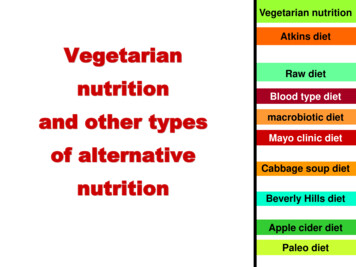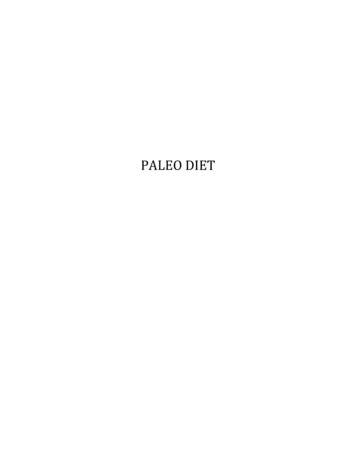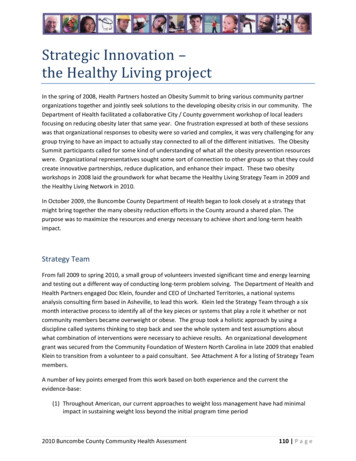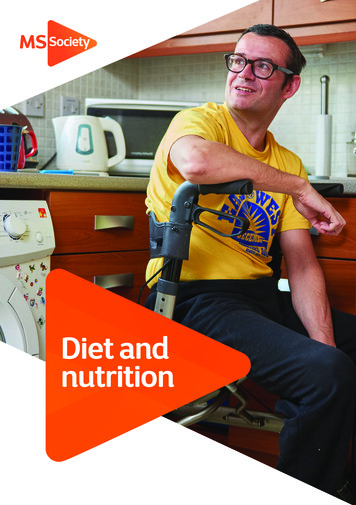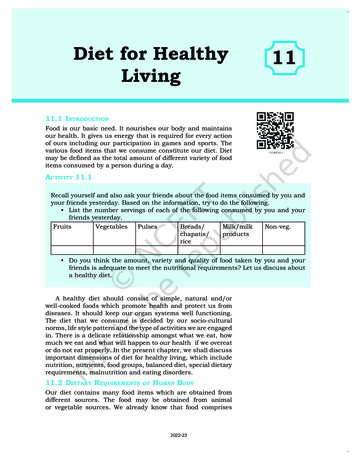
Transcription
Diet for HealthyLiving1111.1 IntroductionFood is our basic need. It nourishes our body and maintainsour health. It gives us energy that is required for every actionof ours including our participation in games and sports. Thevarious food items that we consume constitute our diet. Dietmay be defined as the total amount of different variety of fooditems consumed by a person during a day.Activity 11.1Recall yourself and also ask your friends about the food items consumed by you andyour friends yesterday. Based on the information, try to do the following. List the number servings of each of the following consumed by you and yourfriends n-veg.chapatis/productsrice Do you think the amount, variety and quality of food taken by you and yourfriends is adequate to meet the nutritional requirements? Let us discuss abouta healthy diet.A healthy diet should consist of simple, natural and/orwell-cooked foods which promote health and protect us fromdiseases. It should keep our organ systems well functioning.The diet that we consume is decided by our socio-culturalnorms, life style pattern and the type of activities we are engagedin. There is a delicate relationship amongst what we eat, howmuch we eat and what will happen to our health if we overeator do not eat properly. In the present chapter, we shall discussimportant dimensions of diet for healthy living, which includenutrition, nutrients, food groups, balanced diet, special dietaryrequirements, malnutrition and eating disorders.11.2 Dietary RequirementsofHuman BodyOur diet contains many food items which are obtained fromdifferent sources. The food may be obtained from animalor vegetable sources. We already know that food comprises2022-23
162Health and Physical Education — Class IXconstituents like proteins, carbohydrates, fats andsupplementary substances such as minerals, vitaminsand water that are vital for life. These constituentsare known as nutrients. For proper functioning of ourbody we need to consume body building foods (e.g.milk, meat, poultry, fish, eggs, pulses, groundnuts);energy giving foods (e.g. cereals, sugar, roots, fats andoils); and protective foods (e.g. vegetables, fruits).11.2.1 NutrientsThefood we consume breaks down to simplerproducts before it is absorbed and utilised by thebody. These simpler substances are called nutrients.Our body utilises nutrients for building and repairing,obtaining energy and for protection from diseases.Fig 11.1 : A Vegetarian ThaliWhat is nutrition? The term nutrition is related toour food intake and dietary patterns and utilisation ofprotein, carbohydrate, fat, vitamins and minerals to maintainour health. Most of the natural food items contain more thanone nutrient. Let us understand various nutrients containedin different food items.Fig 11.2 : Protein rich food itemsActivity 11.2Find out fromyourparents/grandparents, thelocally availablefruits and theirvalue to the healthof the body.11.2.1.1 ProteinsProteins are called building blocks of our body. About 20per cent of our body weight comes from proteins. Proteinsare essential for growth and repair of muscle and other bodytissues. Proteins are made of amino acids that contain theelements carbon, hydrogen, oxygen and nitrogen. We obtainproteins from animal as well as vegetable sources. Proteins ofanimal origin are found in milk, eggs, cheese, fish and meat.Proteins from these sources contain all the essential aminoacids (EAA) in adequate amounts. Vegetable proteins are found2022-23Chapter-11 diet for health living .indd 16208-11-2016 11:46:37 AM
Diet for Healthy Living163in pulses (legumes), cereals, beans, nuts, oilseeds, etc.Those who take vegetarian food need to consume moreand a wide variety of these foods to meet their proteinneeds.11.2.1.2 CarbohydratesCarbohydrates are the main source of energyfor our body. There are three major categories ofcarbohydrates, viz. starch, sugar and cellulose. Ourbody breaks down sugar and starch into glucose toprovide energy. Cellulose does not have any nutritivevalue per se, but is a major contributor of dietaryfibres. Excess carbohydrates are converted into fat bythe liver and stored in the adipose tissues in our body.Carbohydrates are of two types – simple andcomplex. Simple carbohydrates are quick energyfoods, e.g. sugar. Sources of simple carbohydrates arenatural fruits, milk and milk products, and vegetablesincluding potatoes and carrots. Complex carbohydratesare better sources of energy than sugar since these arereleased slowly. Sources of complex carbohydrates arebreads, cereals (rice, wheat, bajra, corn, barley, ragi,etc.). We should consume starch and natural sugarand eat whole grains, rice, bread, cereals and fruits toobtain adequate amount of carbohydrates. Fast fooditems such as pizza, pasta, noodles, etc. are rich incarbohydrates only and cannot replace a balancedmeal.11.2.1.3 FatsFats and oils are concentrated sources of energy. Fatsare substances that our body stores for future use.Fig 11.3 : Carbohydrates and VitaminsThese are classified as simple lipids (e.g. triglycerides),compound lipids (e.g. phospholipids), and derivedlipids (e.g. cholesterol). Fats may be obtained from animalor vegetable sources. The major sources of animal fats areghee, butter, milk, cheese, eggs, fish and meat. The sources ofvegetable oils are groundnut, mustard, sesame, coconut, etc.Excess carbohydrates are converted into fats. Fast food itemslike pizza, samosas, burgers are rich sources of fat. Therefore,children who consume only fast food items tend to becomeobese.11.2.1.4 VitaminsVitamins are organic substances that we require in adequatequantities for good health. Our body, however, cannotsynthesise them. Therefore, we need to consume their naturalsources such as fruits and vegetables. Vitamins are divided2022-23Chapter-11 diet for health living .indd 16308-11-2016 11:46:39 AM
164Health and Physical Education — Class IXinto two groups–fat soluble vitamins (Vitamins A, D, E, and K)and water soluble vitamins (Vitamins of B group and VitaminC). Each vitamin has a specific function and its deficiencyleads to a particular deficiency disease.11.2.1.5 MineralsMinerals are the nutrients that are very essential for propergrowth and functioning of our body and are required in smallamounts. Calcium, Chlorine, Copper, Fluoride, Iodine, Iron,Magnesium, Manganese, Phosphorus, Potassium, Sodiumand Zinc are essential mineral nutrients. Some of them areexplained below.Table 11.1 : Vitamins — Sources, Need and Deficiency DiseaseName ofVitaminVitamin ASourcesNeedFat soluble VitaminsMilk, butter, egg,Normalcarrots, cod livergrowth andoil, tomatoes,to keep eyespumpkin, greenand skinleafy vegetableshealthyVitamin DCheese, butter,Formation ofmilk, greenstrong bonesvegetables, fishand teethliver oil, sunlightVitamin E vegetable oils,Protectionof cellspinach, lettuce,turnip leaves,membrane,butter, milk, whole formationgrains, nuts, seeds, of red bloodleafy vegetablescells (RBC)Vitamin K Cabbage,Clotting ofcauliflower,bloodspinach andother green leafyvegetables, cereals,soyabeansWater soluble VitaminsVitamin B1 Seafood, milk,Growth and(Thiamin)meat, peas, cereals, development,green vegetablesreleasingenergy Irregulargrowth ofteethRicketsNot yetconfirmedExcessivebleedingfromwoundsBeri beri2022-23Chapter-11 diet for health living .indd 16408-11-2016 11:46:39 AM
Diet for Healthy LivingVitamin B2 Yeast, egg, meat,(Riboflavin) peas165Body growthand red cellproduction,releasingenergy y skin,Vitamin B3 Whole cereals,(Niacin)tomatoes, potatoes, digestionmeat and fishand nervoussystemVitaminB12Vitamin CLiver, milk, eggs,fishIndian gooseberry(amla), lemons,lime, pineapple,oranges,watermelon, greenpeppers, tomatoes,cabbage, turnip,carrots, greenmint, guavaPellagra(affectsskin,alimentarycanal andnervoussystem)Forming RBC AnaemiaMaintenanceof ligaments,tendons,othersupportivetissues andblood vesselsScurvy(gumsswell andbleed)11.2.1.6 WaterWater is a nutrient and it makes up almost 70 per cent ofour body weight. We need water to break down complex foodmolecules, and transport food, chemicals and gases throughoutthe body. It acts as the medium for biochemical reactions andis also required to eliminate the wastes as urine and sweat. Weshould take 8 – 10 glasses of potable water per day. Inadequatewater intake leads to dehydration. Therefore, intake of waterin proper proportion is important. We should never substitutewater with coffee, tea or soft drinks.Table 11.2 : Important Minerals — Sources and FunctionsName ofMineralIronSourcesNeedMeat, fish, liver,Formation of haemoglobineggs, greenvegetables, turnip,germinating wheatgrains and yeast2022-23Chapter-11 diet for health living .indd 16508-11-2016 11:46:39 AM
166Health and Physical Education — Class IXCalciumMilk and milkproducts, greenleafy vegetables.Phosphorus Meat, egg, fish,whole grainsPotassiumSodiumFormation of strongbones, teeth; clotting ofblood; muscle contractionDevelopment of strongbones, teeth; makingenergy-rich compounds incellsGreen and yellowFor growth; keeping cellsvegetablesand blood healthyCommon salt, also Proper functioning ofin meat and milknervous systemproductsIodineIodised salt,seafood and waterProper functioning ofthyroid – deficiencycauses goitreFluorideCoffee, spinach,onion and teaMakes enamel of teethhard and prevents dentalcariesCopperGrains, nuts andchocolateZincMeat, eggs andfishHelps in formation andfunctioning of RBC,connective tissue andnerve fibresFor insulin production,digestion, metabolism;functioning of maleprostateChlorideMeat, milkproducts and fishActivity 11.3Prepare a list offood items youconsumed lastweek at breakfast,lunch and dinner,and record thenutrients containedin by them.Functions of muscles andnerves and digestion11.3 Balanced DietActivity 11.4Find out thenumber ofglasses of watereach of yourten classmatesconsume in a day.You have already learnt in earlier classes that a diet whichcontains all the essential nutrients like proteins, carbohydrates,fats, minerals and vitamins in the proportion required for thenormal growth and development of the body, is called balanceddiet. The quantity of nutrients in a balanced diet will alwaysvary with age, sex and physical activities undertaken by anindividual. The important components of a balanced diet aregiven in table 11.3 below.Table 11.3 : Food Required for a Normal PersonFood GroupCerealsQuantity per portion/serving1 roti ( 25 gm wheat flour), bread, 1 katori rice,25 gm raw dalia/cornflakes/sooji or rawa2022-23Chapter-11 diet for health living .indd 16608-11-2016 11:46:39 AM
Diet for Healthy LivingPulsesMilkFruits andvegetablesFats and oil16725 gm raw dal1 glass or 250 ml milk (low fat)100 gm fruit,100–125 (gm) raw vegetables1 teaspoon (5 gm)Source: Health Awareness for Parliament, MOHFW; GOI: 2002To understand which kind of food will give us the rightbalance of nutrients, food items are divided into six majorgroups given in the table below. Food items in one groupcannot replace those in another.A nutritionally balanced diet should contain items from allthe above major food groups.Table 11.4 : Major Food GroupsFoodGroupsCereals,MilletsFood ItemsNutrientsRice, wheat, bajra,maize, jowar, ragiCarbohydrates, proteinsPulsesLentil, grams, soya,peasCarbohydrates, proteinsMilk andmilkproductMeat, fishand fowlsVegetablesMilk, yogurt, cheese, Fats, proteins, minerals,paneer, ice-creamwater, carbohydrates,vitaminsMeat, fish, chicken, Proteins, fatsnutsCarbohydrates,Green leafyvegetables, rootsvitaminsminerals, waterOrange, banana,Carbohydrates,apple etc.vitaminsFruits11.4 Special Dietary RequirementsThe amount of food or nutrients required by a person in a daydepends upon the need for energy and specific demands of aperson. These needs are directly related to age and physicalactivity. During the rapid growing years, i.e. 12 – 22 years forboys and 12 – 18 years for girls, there is a gradual increase indaily food requirements. But as we grow old, our daily needfor energy decreases. The amount of energy required by peopleengaged in low, moderate or high level of physical activitydiffers.A sportsperson always needs to consume more calories thana non-sportsperson. Similarly, the dietary needs of a womanduring pregnancy and lactation are higher. Let us discuss thedietary requirements of different individuals.2022-23Chapter-11 diet for health living .indd 16708-11-2016 11:46:39 AM
168Box 11.1Food habits suchas eating fastfood regularly,skipping meals,etc. contributeto nutritionaldeficiency amongadolescents,especially girls.Health and Physical Education — Class IX11.4.1 Diet for AdolescentsWe know that during adolescence, changes take place inthe body composition of boys and girls; and as a result theirnutritional requirements increase. Girls need more mineralslike calcium and iron. Adolescent girls and boys need to takecalcium rich food to keep their bones, teeth and muscleshealthy; and iron rich food to keep them strong. Therefore, itis essential for them to consume more dairy products, beansand green leafy vegetables in their diet. Young girls takinginadequate diet may suffer from nutritional problems like irondeficiency anaemia and obesity. This may be due to refusal toeat food to maintain weight or binge eating habit. Furthermore,an under nourished adolescent girl is at a risk of developingcomplication during pregnancy and child birth.11.4.2 Diet for Pregnant Women and Lactating MothersFig. 11.4 : Calcium rich Dietand Iron rich DietActivity 11.51. List the myths inrespect of diet foradolescent girls,pregnant andlactating women,prevalent in yourlocality.2. Express youropinion regardingthese myths.3. Discuss thesemyths with yourfriends and teacher.Women always require more iron than men. Pregnant andlactating mothers have special dietary needs. In our country,it is seen that pregnant and lactating women do not takehealthy diet because of lack of availability and lack ofimportant nutritional information. A pregnant and a lactatingmother requires additional energy over and above her normalrequirements. There is also an increased need for protein,calcium and iron. Inadequate intake of nutrients causesharm to the foetus and the child. Mothers should follow theguidelines for intake of nutrients available from the nearbyhealth centre and gather knowledge regarding weight gain andsupplementation. Besides food, normal physical activities andlight exercises like walking should be performed by pregnantwomen in consultation with the doctor or health worker.Good nutrition during pregnancy promotes healthy weightof the newborn. Low birth-weight children are prone to variousdiseases during adulthood. Therefore, pregnant women andmothers should keep the following in mind. Include all food groups in daily diet. Care should betaken to include cereals, pulses, ghee-oil, sugar, jaggery,vegetables, fruits, milk and its products in the daily diet.Table 11.5 : Additional Calorie Requirment duringPregnancy and LactationFoodItemDuring PregnancyQuantity Calories(kcal)During 3Pulses15g.5230g.1052022-23Chapter-11 diet for health living .indd 16808-11-2016 11:46:39 AM
Diet for Healthy .40Source: ICMR (1990) Recommended Dietary Intakes for Indians, New Delhi Consume more foods containing iron like green leafyvegetables, black sesame seeds (til), raisins, jaggery,poha. Consume more foods like milk and its products (viz. curd,paneer, kheer), white sesame seeds (til), ragi, guava andbajra, which provide all the calcium and protein needed. Do not restrict diet. Have a balanced diet. Table 11.5 presents the additional calorie requirementduring pregnancy and lactation.11.4.3 Diet for SportspersonsAll kinds of physical activities burn a lot of energy. Sportspersonsundergo physical training which involves regular strenuousexercises for a long period for developing physical fitness andimproving performance. They, therefore, need more calories forenergy. Even persons who do not participate in competitivesports but undertake exercise programmes for physical fitnessneed extra energy. Accordingly, they are required to plan theirdiet.Let us have a look at the table given below to understandthe energy expenditure of a person of age between 20 to 39years, with a body weight of approximately 60 kg by variousactivities.These additional requirement of nutrients for training loadcan be achieved with a balanced diet. In the past, athleteswere advised to take large amount of protein from eggs, meatand milk, but it is now generally accepted that carbohydrateand not protein, is the best source of energy. One should alsoremember that extra protein intake does not increase muscles.Table 11.6 : Energy Expenditure of a Person by VariousPhysical Activities pping210Walking 4 km/hr160Gardening300Running 6 km/hr353Cycling 15 km/hrVolleyball360180Running 10 km/hrRunning 12 1322022-23Chapter-11 diet for health living .indd 16908-11-2016 11:46:40 AM
170Health and Physical Education — Class IXDiet containing complex carbohydrates is always preferredover that containing simple sugar. In case of sportspersons, adietary carbohydrate intake of 500-600 gm/day is necessary toensure adequate glycogen synthesis. Carbohydrates break intosugars that give energy. Extra sugar is converted into glycogenand stored as adipose tissue by the liver. It is broken down tosimple sugar whenever energy is required. An athlete needs tochoose foodstuffs from all groups displayed in the food pyramidand pay attention to the intake of adequate water.In planning one’s diet, care must be taken to follow goodeating habits that we discussed earlier. Physical activities maybe performed after at least three hours of taking a principalmeal and after half an hour of taking light food. A sportsperson’sdiet is very important not only during the training period, butbefore and after the competitions too.Fig. 11.5 : Food Pyramid for Balanced Diet2022-23Chapter-11 diet for health living .indd 17008-11-2016 11:46:40 AM
Diet for Healthy Living17111.4.3.1 Diet before CompetitionThe pre-competition meal needs to be high in carbohydrates,low in fat, low in protein, low in fibre, enjoyable and familiarto the participant. Food may include breakfast cereals, bread,roti, fruits, fruit juice, boiled rice, potatoes, sweet potatoes,biscuits and carbohydrate drinks.11.4.3.2 Diet on Competition DayOn the day of competition, the most important thing to rememberis never to try anything new. An athlete must follow a simpleand sound nutritional routine. If the competition is held inthe morning, just eat a light carbohydrate-rich breakfast withplenty of fluids, cereal with milk, bread or roti. Large quantitiesof sugar, confectionery or honey should be avoided. Food thatmay upset the stomach and make feel heavy may be avoided.11.4.3.3 Eating just before CompetitionSmall amount of food containing carbohydrates just beforecompetition helps to delay fatigue and improve endurance.11.4.3.4 Drinking during CompetitionHave your last drink 15 – 20 minutes before actual competition.It is essential to drink water at regular intervals to avoiddehydration. Right kind of sports-drinks hydrate our body andalso supply energy.Box 11.211.5 Yogic DietAyurveda advise a sattvic, which is a vegetarian diet, consistingof natural food items. According to yogic dietetics, naturalfood items are easy to digest and assimilate. Yogic diet is acombination of raw food and proper fasting routine. Goodraw food, such as cucumber, radish, carrots, tomatoes,sprouts, together with spices like ginger, cayenne, cinnamonand basil provide energy to the mind and the body. Takingregular yogic diet and performing asanas, pranayama andmeditation contribute to the well-being of our body and mind.For preparation of yogic foods, steaming is considered to be thebest method.11.6 MalnutritionIt is now clear that a balanced diet is very important for ahealthy life. An imbalance between the body’s nutritional needsand the intake of nutrients leads to malnutrition. Commonlymalnutrition is considered in terms of hunger, whereas, bothunder-nutrition and over-nutrition are forms of malnutrition.Ayurveda suggeststhe following itemsin a wholesome diet Rice Millet Wheat Green gram Coriander Vegetable Grapes, mangoes,Dates Cow’s milk Turmeric (haldi) Cumin (jeera) Do not fill yourstomach withextra food. Eat food atregular intervals.2022-23Chapter-11 diet for health living .indd 17108-11-2016 11:46:40 AM
172Health and Physical Education — Class IX(a) Under-nutrition:specific deficiencyMalnutrition(b) Over-nutrition:overweight and obesityBox 11.3Nutritionalimbalance resultingfrom inadequateintake of nutrients isreferred to as undernutrition.11.6.1 Types of Malnutrition11.6.1.1 Under-nutritionIt does not occur in a single day’s food intake. Deficiency causedby under-nutrition affects us after long term of negligence.An under-nourished child cannot grow fully, physically andmentally. In most of the developing countries, under-nutritionis a threat to public health as it leads to illness and even death.In addition to inadequate intake of nutrients, under-nutritionMarasmusKwashiorkorFig. 11.6 : Under-nutrition childrenis also the result of malabsorption of food, addiction to drugsor loss of nutrients from body due to various medical reasons.Under-nutrition may lead to deficiency diseases, like proteindeficiency diseases which include kwashiorkor, marusmus,mineral deficiency diseases like goitre, anaemia; and vitamindeficiency diseases like scurvy, beriberi and rickets.Ignorance, lack of education and poverty led by relativelyhigh food prices, natural disasters causing insufficientagricultural productivity and unhealthy dietary practices aresome important common causes of under-nutrition. Undernutrition continues to be a significant health problem forchildren and adults in India. The National Family HealthSurvey 3 (NFHS) reported that in our country the prevalence of2022-23Chapter-11 diet for health living .indd 17208-11-2016 11:46:40 AM
Diet for Healthy Living173under-nutrition is high among children. At present, Activity 11.640 per cent children of less than five years of age inConduct a survey in your familyour country are underweight.and the neighbourhood toFor the management of under-nutrition,find out facts regarding theimprovement in nutritional status is required. Thefollowing:Government of India provides mid-day meals to the1. How many malnourishedstudents of up to elementary stage during schoolchildren are there?hours.2. What are the reasons ofMany myths and taboos about diet are alsomalnourishment of thoseresponsible for under-nutrition in our country.children?Due to ignorance and illiteracy, locally availablenutritious food is not eaten. In case of new bornbabies, inadequate breastfeeding is a major cause of undernutrition. In fact, exclusive breast feeding during the first sixmonths of life is very important.11.6.1.2 Over-nutritionOver-nutrition is also a form of malnutrition that resultsfrom overeating and excessive intake of specific nutrientslike carbohydrate and fat. Inadequate exercise andovereating are the major causes of overweight. Due to intakeof excessive food, adipose tissue increases abnormally inthe body that enlarges or the number of fat cells increaseleading to obesity. We find obese persons bulky andoverweight because of the accumulation of fat in the body.People who eat more need to burn more calories, otherwisesurplus calories are stored as fat.In modern societies obesity has become an epidemic.It occurs in both developed and developing countries andaffects children as well as adults. In addition to overeatingand inactivity, the major reasons of overweight and obesityare sedentary life style, emotional problems and physiologicalFig. 11.7 : Over-nutritiondisturbances including genetic factors. Metabolic anddigestive disorders take place due to overconsumption of fats, fast foods, soft drinksBox 11.4and refined white flour carbohydrates,combined with low fibre intake.Obesity: Overweight and obesity are notOverweight and obese children andthe same. Obesity is a health conditionadolescents frequently grow to becomein which excess body fat accumulatesobese adults. Obesity tends to run into the extent that it may have anfamilies, suggesting a genetic link too,adverse effect on health and reduceas families share common dietary andlife expectancy. When body fat contentphysical activity patterns, attitude, lifestyleexceeds 25 per cent for men or 30 perand habits which contribute to obesity.cent for women of the total body weight,Planning for balanced diet and regulara person is called obese. Calculatingexercise is of utmost importance to preventBMI is given in Chapter 4?overweight and obesity.2022-23Chapter-11 diet for health living .indd 17308-11-2016 11:46:41 AM
174Health and Physical Education — Class IX11.6.2 Assessing the BMIBody Mass Index (BMI) is an index of weight-for-height that iscommonly used to classify adults as underweight, overweightand obese. It is obtained by dividing the weight in kilogramsby the square of the height in metres (kg/m2). For example, anadult who weighs 70kg and whose height is 1.75m will have aBMI of 22.9.Table 11.7 : BMI ChartBMICategory2 18 Kg/mUnderweight18-23 Kg/m2Ideal body weight23-25 Kg/m 25 Kg/m2OverweightObese2Source: National Programme for Prevention and Control of Cancer, Diabetes,Cardiovascular Diseases and Stroke: A Guide for Health Worker. DirectorateGeneral of Health Services, MoHFW; GOI, 201111.7 Eating DisordersEating disorders are severe disturbances in eating behaviourcommonly seen among adolescents between ages 14 to 18years. Disordered eating patterns are either characterised byrefusal of food to maintain the body weight or recurring bingeeating followed by vomiting. The former restrictive type disorderis known as Anorexia Nervosa and the later, Bulimia Nervosa.Most people do not seek help for eating disorders; some maynot even be aware that they have a problem.11.7.1 Anorexia Nervosa (AN) (Refusal to eat food)Fig. 11.8 : AnorexiaNervosaBox 11.5Anorexia Nervosaresults from refusalto eat or lack ofappetite or dislikingfood leading tostarvation tomaintain a bodyimage.Anorexia Nervosa is a psychological disorder caused by undernutrition. People with such disorder become thin and lose a lotof weight. An obsessive fear of gaining weight occurs in suchcases. Anorexia nervosa is an attempt to use food and weight todeal with emotional problems, physical changes, peer pressureand stress. It is a serious mental illness with a high incidenceof morbidity and mortality.Extreme fasting, indulging in over exercise, dieting mayresult in anorexia nervosa. Teenage girls and young womenare more likely to develop this disorder. However, this disordercan occur during adulthood too.11.7.2 Bulimia Nervosa (Recurrent binge eating)Bulimia Nervosa is an eating disorder characterised byrecurrent binge eating, followed by compensatory behaviour.The most commonly observed behaviours include defensivevomiting, sometimes called purging, fasting, using laxativesand over- exercising.2022-23Chapter-11 diet for health living .indd 17408-11-2016 11:46:41 AM
Diet for Healthy Living175The onset of bulimia nervosa is generally observed duringmid to late adolescence. It is 20 times more common in females.Bulimia nervosa is rarely seen in those under 14 years. Ithas also been observed that there is higher incidence of majordepressive disorder in close relatives of patients with bulimianervosa.The common causes of the disorder are family problems,inability to adjust in society, lack of self-identity, conflict,problem with body image, depression and other psychologicalproblems. The person tries to express emotions that areotherwise difficult, becomes extremely engaged with emotionsand is so tied up with a relationship with food and weight thatit becomes difficult for him/her to deal with it.Health problems caused by both the above conditionsinclude:(a) tooth decay, toothaches, swollen gums, gum disease(gingivitis), and erosion of tooth enamel, which arecaused by acid in the mouth due to vomiting.(b) osteoporosis.(c) abnormal heart beat.(d) dehydration, which can lead to weakness, fainting.(e) fainting due to low blood pressure.(f) low body temperature.(g) suicide risks when a person feels discouraged due topresence of one of the conditions or has ongoing bodyimage issues.Anorexia and bulimia can lead to delay in the onset ofmenstruation in girls.There is a need to focus on fitness rather than on weightreduction. Sitting in front of TV or computer for long hours,eating junk food, or having high calorie drinks add to obesity.It is seen not only in the affluent section but also in urban poor.Since obesity is more a lifestyle disease, it needs interventionat the level of the person himself/herself and at the level of theentire family, school and the community. Proper eating habits,diet and exercise are the essential requirements for physicalfitness and management of weight.2022-23Chapter-11 diet for health living .indd 17508-11-2016 11:46:41 AM
176Health and Physical Education — Class IXAssessmentAnswer the following questions1. Define the terms nutrition and nutrients.2. List the various constituents of food and mention theirfunction in the body.3. Why is it important to recommend special diet forpregnant and lactating women and sportpersons.4. Why is water considered a necessary constituent of thediet?5. List the nutritional disorders and state one characteristicof each.Fill in the blanks(i) Vitamin A is a .soluble Vitamin.(ii) Vitamin C is a .soluble Vitamin.(iii) .
into two groups–fat soluble vitamins (Vitamins A, D, E, and K) and water soluble vitamins (Vitamins of B group and Vitamin C). Each vitamin has a specific function and its deficiency leads to a particular deficiency disease. 11.2.1.5 Minerals Mine


